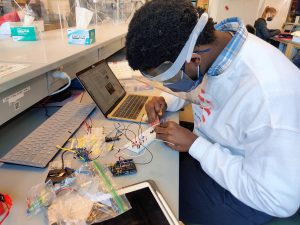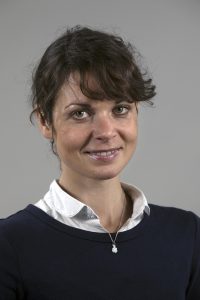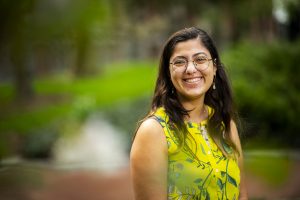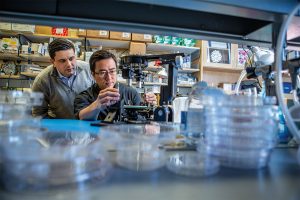by Erica K. Brockmeier

While the majority of courses remained online this spring, a small number of lab-based undergraduate courses were able to resume limited in-person instruction. One course was BE 310, the second semester of the Bioengineering Modeling, Analysis, and Design lab sequence. Better known as BE-MAD, this junior-year bioengineering course was able to bring students back to the teaching lab safely this spring while adapting its curriculum to keep remote learners engaged with hands-on lab modules at home.
An Essential Step Towards Becoming a Bioengineer
After learning the basics of chemistry, physics, biology, and math during freshman year and studying bioengineering fundamentals throughout sophomore year, BE-MAD is designed to provide essential hands-on experience to bioengineering majors during their junior years. In BE-MAD, students integrate what they’ve learned so far in the classroom to addressing complex, real-world problems by breaking down the silos that exist across different STEM fields.
“Usually what we hear from students is that this BE 309/310 sequence is when they really feel like they are engineers,” says Brian Chow, one of the BE 310 instructors. “They can put what they learn in classes to work in some practical setting and applied context.”
BE-MAD is also an important course to prepare students for senior design and is designed to be a “safe space to fail,” allowing students to build confidence through trial and error within a supportive environment, explains Sevile G. Mannickarottu, director of the educational laboratories. “We’re trying to build skills needed for senior year as well as teaching students how to think critically about problems by pulling together the materials they’ve learned all in one place,” he says. “By senior year, we want them to, when presented with a problem, not be afraid.”
Adapting BE-MAD for Both Remote and Hybrid Instruction
Traditionally, the BE-MAD lab is taught in the George H. Stephenson Foundation Educational Laboratory & Bio-MakerSpace, the primary bioengineering teaching lab, and includes modules on dialysis, drug delivery, insect limb control, microfluidics, cell-cell communication, ECG analysis, and spectroscopy. In the fall, the first lab in the series (BE-309) pivoted to remote learning using video tutorials of lab experiments and providing real data to students for analysis.
This spring, with more aspects of on-campus life able to reopen, the Educational Laboratory staff and BE-MAD instructors developed protocols in collaboration with David Meaney, Penn Engineering senior associate dean and an instructor for BE 309, and Penn’s Environmental Health and Radiation Safety office to safely reopen the teaching lab and Bio-MakerSpace for both BE-310 and for bioengineering senior design students.

To continue to meet the needs of remote students, BE 310 instructor Lukasz Bugaj says that the curriculum was adapted to be two parallel courses—one that could be done entirely at home and the other in-person. The challenge was to adjust the content so that it could be completed either in-person or virtually, and could be switched from in-person to virtual at a moment’s notice because of COVID precautions, all while maximizing the hands-on experience, says Bugaj. “That’s a real credit to the lab staff of Sevile and Michael Patterson, who put a lot of work into revamping this entire class.”
Read the full story in Penn Today.



